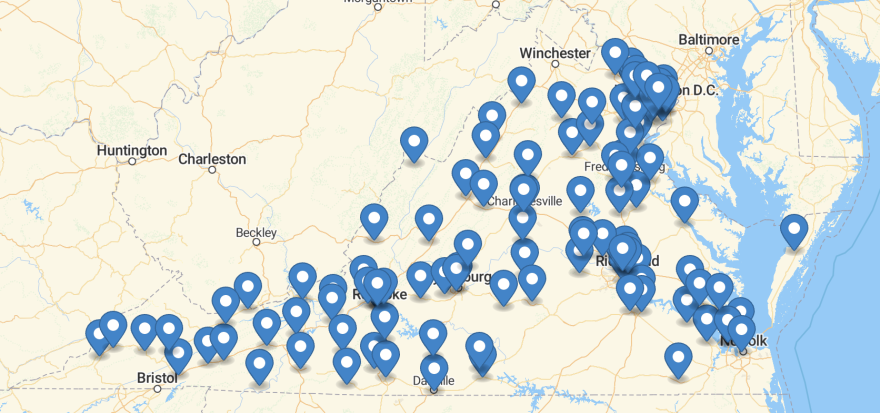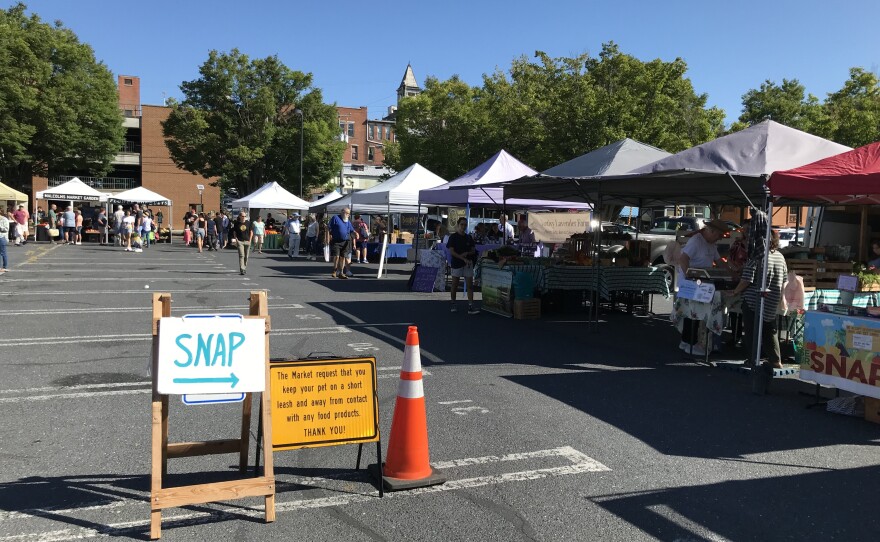Tucked up against the West Virginia border, Highland County is the least populous county in Virginia, with a little more than 2,200 residents. It has more sheep than people and is famous for being one of the southernmost points in the country where maple syrup is produced.
The town of Monterey, population 265, is the county seat. It's a half-mile by half-mile diamond at the base of one of Highland’s many valleys. The town’s east and west ends rise up into some of the Allegheny Mountains’ peaks then give way to a big sky.
Elizabeth Lohr-Myers runs The Highland Center, a nonprofit that puts on a farmers market on Fridays, along with programs ranging from chili cook-offs to regional economic development opportunities.
“We say that we're four mountains from anywhere here, because to get to any real sort of civilization, it takes at least an hour,” she said.
While locals cherish the county’s isolation and natural beauty, Lohr-Myers said access to food has been scarce.
“The farmers market was our very first program back in 1997, and there was a grocery store here at the time,” she said. “But in most of the years in between 1997 and now, there has not been a grocery store in Highland County. So, the farmers market has really been the only source for fresh, local foods.”
Food deserts and farmers markets
According to the Virginia Department of Health’s food accessibility indicator, the county ranks 132nd of 133 counties and independent cities for food access. And according to Lohr-Myers, that scarcity shapes life in the area as residents have to think ahead about their food supplies.
“Almost anyone you stop in Highland County will have a cooler in their back seat or their trunk, because … we're all used to driving at least an hour or an hour-and-a-half to get our groceries every week,” she said.
While extreme, that experience is not unique to Highland County. Data from the U.S. Department of Agriculture shows food deserts cover about 40% of Virginia census tracts, hitting rural areas particularly hard.
In this case, a food desert is defined as census tracts where at least 500 people or 33% of the population live farther than 1 mile (urban) or 10 miles (rural) from the nearest supermarket.
The USDA tracks food deserts using this map. Census tracts are highlighted if at least 500 people or 33% of the population lives farther than 1 mile (urban) or 10 miles (rural) from the nearest supermarket.
To Kim Hutchinson, executive director of the Virginia Farmers Market Association, those food deserts highlight the role of farmers markets in providing greater food access.
“We have 265 [markets] around the state,” Hutchinson said, adding “over a third of all farmers markets in the state of Virginia are in what are known as food deserts.”

Markets accept SNAP, other benefits
But food access is more than just how close a person is to a store. Due to poverty, about 1 in 10 Virginians are food insecure, according to the Federation of Virginia Food Banks.
To address this and their reputation for being expensive, more than 100 farmers markets in the commonwealth and thousands around the country accept EBT SNAP benefits as payment.
Those benefits — formerly known as food stamps — allow customers to purchase meat, dairy, fruits, vegetables, baked goods and more with their SNAP debit card.
And the SNAP program isn’t alone. Seventy-five markets now accept Virginia Fresh Match, a program that gives SNAP recipients coupons to buy produce to double their SNAP funds.
Additionally, many farmers market vendors accept checks from the new Senior & WIC Farmers' Market Nutrition Program, aka Virginia Farm Market Fresh.
Administered by the Virginia Department for Aging and Rehabilitative Services, the program gives people checks to buy fresh produce from farmers markets. To qualify, Virginia residents must be enrolled in the federal Women, Infants, and Children food assistance program and/or be 60 and older, along with making up to 185% of the poverty line. The program runs from June 1 to Nov. 18 each year to line up with the harvest season. Applicants must reapply each year.
Together, these programs and their widespread availability — even in many rural areas — challenge farmers markets’ reputation for being only accessible to wealthy people in urban areas.
SNAP awareness
While the Highland County farmers market accepts these programs, when VPM News was there earlier this month, no one used them.
Lohr-Myers, who runs the market, said awareness plays a role in that.
“Next year, we really want to focus on advertising the benefits that are available at the market and helping people realize that they can come and get free healthy foods here,” she said.
Highland County has a poverty rate of 13%; the statewide rate is 10%. And while food deserts disproportionately affect rural areas, people who live in urban areas are also affected — especially if they don’t have a car.
One hour east of Monterey, about 9% of Staunton households (approximately 26,000 people) don’t have a car, according to Virginia Department of Health data. In the city’s northern portions, that number jumps to 12%. But where people know about the programs, they use them.

At the Staunton Farmers’ Market, held the day after Highland County's, about 20 people used the SNAP program, spending about $600 before their benefits were doubled by Virginia Fresh Match coupons.
Ashley Malcolm runs the Staunton Farmers’ Market. She’s also a farmer who sells at the market and accepts SNAP.
“Maybe five, 10% of our total sales are through these programs,” she said. “So, it's still relatively a small impact, and there's room for more growth there; the more people find out about it, the more people see the value of it.”
Malcolm said she started selling at the market to increase residents’ access to her food.
“By being a part of the farmers market, I wanted our food to be accessible,” she said. “Not just for the people who can afford it, but to be able to be purchased by everyone.”
Malcolm said she saw a big increase in the use of benefit programs when Virginia released its Pandemic-EBT benefits. The P-EBT program gave families with children either enrolled in certain schools or on free and reduced-price lunch a debit card loaded with cash like regular SNAP benefits.
Hutchinson, of the Virginia Farmers Market Association, saw the same increase.
“From the market managers that accept the programs, across the board, they told me they had a 500-plus-percent increase in usage once the P-EBT dropped. It was unbelievable,“ Hutchinson said.
While the other programs continue, P-EBT issued its last benefits over the summer. Hutchinson said that program’s end — in addition to large cuts in SNAP benefits that about 500,000 Virginians experienced earlier this year — is a big hit to many families’ ability to put food on the table.
“With the increased cost of food and supply chain issues we're seeing, it's more critical than ever that we have all these different programs out there that reach a wide breadth and scope of individuals to give them help in being able to buy local food,” she said.
Despite the end of the P-EBT program, she remains optimistic about farmers markets increasing food access — especially for poor and rural Virginians.
“I want folks to know that this is where you go to get your local food,” Hutchinson said. “And you want to go to a big-box store and get all your toilet paper and stuff, that's fine. But come buy your fruits and vegetables, your milk, your cheese, your beef and your pork and chicken from the farmers market and support your local farmers.”
Malcolm, the Staunton market manager, is also optimistic about the future, especially for newer customers brought in by the P-EBT program.
“I'm hoping with the knowledge of what our market has to offer — not just fruits and vegetables, but meats, eggs, cheeses, all of the things that qualify for the SNAP program — that they … continue to be customers for years to come,” said Malcolm, who added, “whether they participate in the program or not.”
With the latest Census Bureau data showing poverty increased last year by the most it has in more than 50 years, it's likely Malcolm will see more customers using SNAP as new recipients look for ways to make ends meet.



